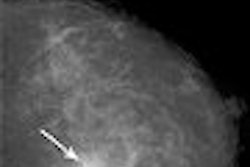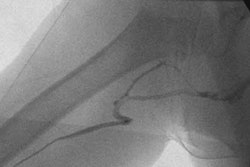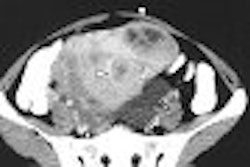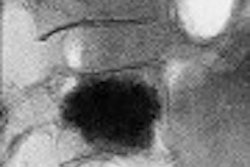Perhaps they should rename it vertebroblasty -- the radiation dose to interventional radiologists during vertebroplasty is fairly high, according to Japanese researchers. In fact, using a 1-mL syringe technique, an operator could reach the recommended dose limits within five years. However, using a bone cement injector can reduce that risk.
Operators can be exposed to radiation during the multiple stages of percutaneous vertebroplasty, explained Dr. Atsushi Komemushi, Ph.D., and colleagues from Kansai Medical University in Osaka, Japan.
"Radiation exposure is high while inserting the needle into the vertebra and injecting bone cement under lateral fluoroscopic guidance because the operator must stand near the radiation source and fluoroscopy is continuously used," the group wrote (Journal of Vascular and Interventional Radiology, October 2005, Vol. 16:10, pp. 1327-1332).
Four interventional radiologists with at least eight years of experience participated in this study. Twenty patients were enrolled and placed into one of two groups: those who would undergo vertebroplasty with a 1-mL syringe injector and those who would have the procedure done with a bone cement injector. An operator randomly selected either the 1-mL syringe or the cement injector just prior to surgery.
Dose penetration was measured at 10-mm tissue depth outside the lead apron (Ha) and inside the lead apron (Hb). Effective radiation dose (HE) also was calculated.
Percutaneous vertebroplasty procedures were performed under IVR-CT guidance (Advantx ACT, GE Healthcare, Chalfont St. Giles, U.K.). Pulse fluoroscopy was done at 60 pulses per second. The x-ray system (MAXIRray 150TH, GE Healthcare) was calibrated to deliver an image intensifier input dose of 12.32 µGy/min, with a 40-cm field-of-view (FOV) in fluoroscopy. During digital x-ray, the FOV was 22 cm and the dose was 4.4 µGy/frame. The tube potential was 80-90 kVp and the tube current was 800 mAs.
In the 1-mL syringe group, 19 vertebrae were treated during 10 procedures; in the bone cement injector group, 16 vertebrae were treated during 10 procedures. There were no complications.
The average fluoroscopy time between the two groups did not differ greatly at 7.54 minutes for syringe and 6.6 minutes for cement injection. The similarities ended there. The average Ha measurement for the syringe was 230.8 µSv and for the cement injector it was 116.2 µSv. The average Hb measurements were 14.5 µSv for syringe and 11.3 for cement injector. Finally, the average HE measurements came in at 28.3 µSv for syringe and 19.7 µSv for cement injectior.
"Ha, Hb, and HE for the 1-mL syringe group were significantly higher than for the bone cement injector group," the authors stated. "The dose limit for HE could be reached over a five-year period with 2,074 procedures for the 1-mL syringe group and with 5,076 procedures from the bone cement injector group."
By Shalmali Pal
AuntMinnie.com staff writer
December 5, 2005
Related Reading
Bone cement for osteoporotic vertebral fractures cleared by FDA, April 6, 2004
Copyright © 2005 AuntMinnie.com



















